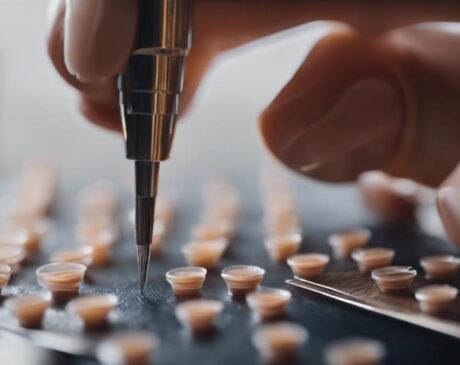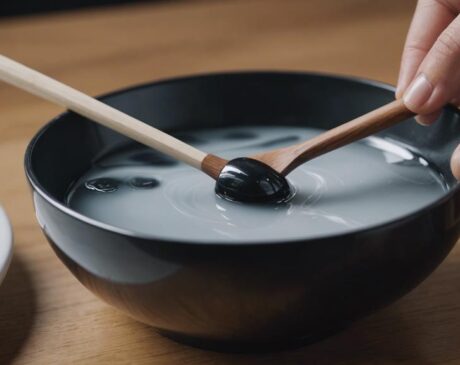How Do Nail Salons Remove Acrylic Nails?
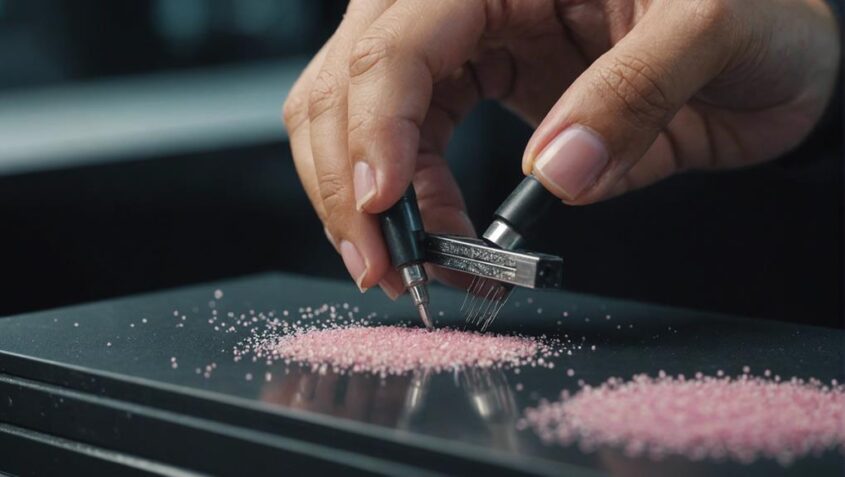
Nail salons employ a variety of methods to remove acrylic nails effectively. Acetone soaking dissolves the adhesive bond and softens the acrylic layers. Buffing and filing gently remove the remaining product and shape the nails for a seamless finish. Foil wrapping with acetone-soaked pads speeds up the breakdown process. Nail drills efficiently file away acrylic material, saving time and ensuring a uniform removal. Moisturizing and cuticle care promote nail health and appearance. The final step involves buffing, applying a top coat, and shaping the nails. These techniques provide a professional and polished result for acrylic nail removal.
Key Takeaways
- Acetone soaking dissolves acrylic bond effectively.
- Foil wrapping enhances removal potency and efficiency.
- Buffing and filing techniques ensure a seamless transition.
- Nail drills offer controlled and efficient acrylic removal.
- Moisturizing and cuticle care promote nail health during the removal process.
Soaking the Nails in Acetone
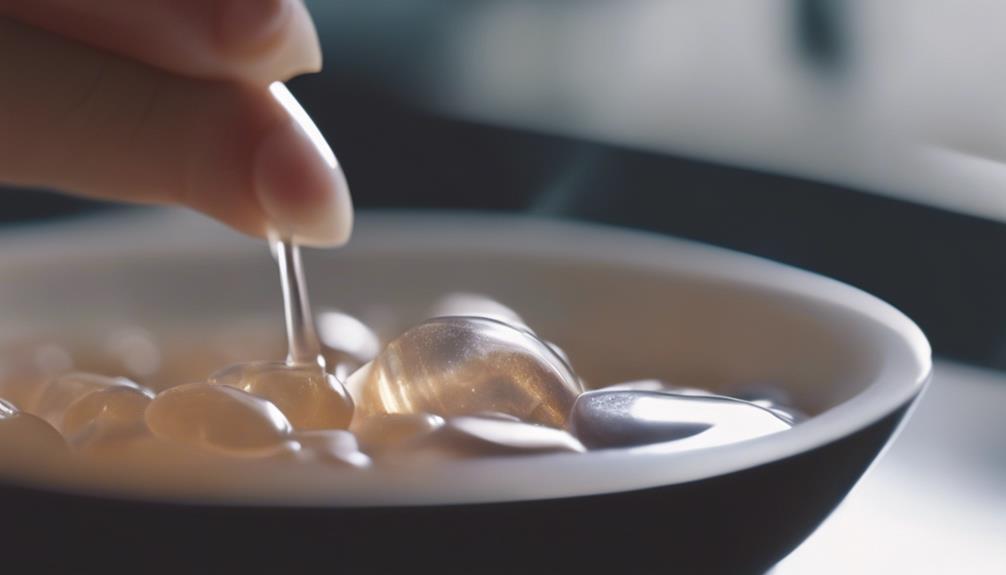
Acrylic nails are typically removed at nail salons by soaking the nails in acetone, a common method that effectively dissolves the adhesive bond. Acetone, a solvent known for its ability to break down various substances, works by penetrating the layers of acrylic and softening the bond between the artificial nail and the natural nail plate. This process allows the nail technician to gently separate the acrylic from the natural nail without causing damage.
Salons often use techniques to enhance the acetone soaking process, such as wrapping the nails in foil to create a barrier that helps retain the acetone's potency. Innovations in the industry have led to the introduction of acetone-infused gel pads or caps that provide a more secure and comfortable fit, ensuring maximum contact between the acetone and the acrylic for efficient removal. Additionally, some salons incorporate moisturizing agents into the acetone solution to counteract the drying effects of acetone on the skin surrounding the nails.
Buffing the Acrylic Surface
To achieve a smooth and natural finish when removing acrylic nails, the next step involves gently buffing the surface of the artificial nail. Buffing the acrylic surface is a crucial step in the acrylic nail removal process as it helps to remove any remaining product and smooth out the nail for a seamless transition. Nail technicians use a buffer or a file to gently buff the acrylic, taking care not to damage the natural nail underneath. This step requires skill and precision to ensure that the nail is left in optimal condition post-removal. Innovations in buffing techniques have led to the development of specialized buffers that are gentle yet effective in removing acrylic residue without causing harm to the natural nail. By utilizing these modern tools and techniques, nail salons can provide clients with a professional and high-quality acrylic nail removal experience that prioritizes nail health and aesthetics.
Wrapping the Nails in Foil
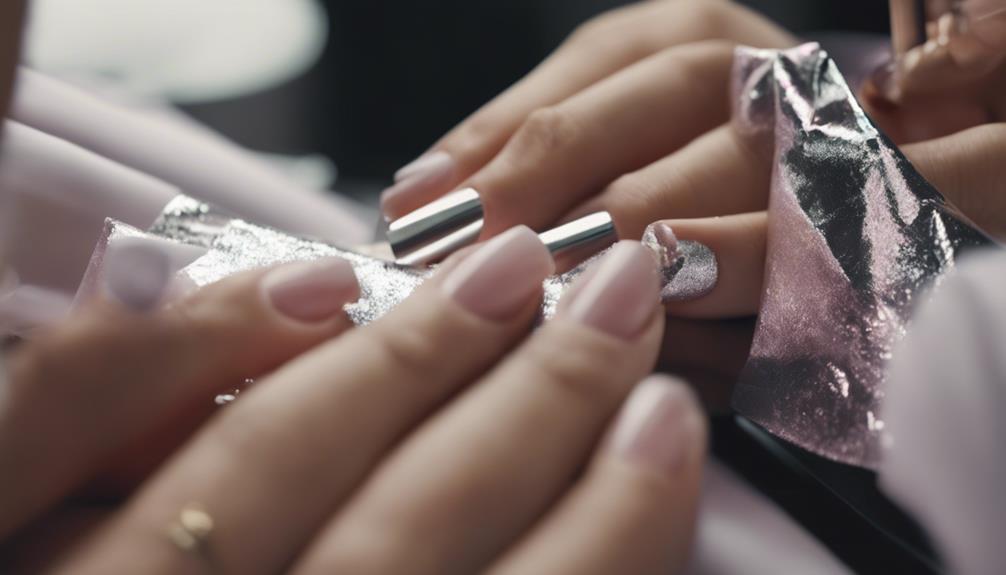
Wrapping the nails in foil is a crucial step in the acrylic nail removal process at nail salons. This technique involves carefully enclosing each nail in foil to allow the acetone to effectively break down the acrylic. The duration of wrapping and the efficiency of the removal technique play key roles in ensuring the acrylic is safely and completely removed.
Foil Wrapping Process
The process of encapsulating nails in foil during the removal of acrylic nails is a common practice in nail salons. This innovative technique involves wrapping each nail with a cotton pad soaked in acetone and then covering it tightly with aluminum foil. The foil wrapping process creates a sealed environment around the nails, allowing the acetone to effectively break down the acrylic material without evaporating quickly. This method is preferred for its efficiency in loosening the acrylic, making the removal process smoother and less damaging to the natural nails underneath. Nail technicians often use this foil wrapping technique to ensure thorough and precise removal of acrylic nails, providing clients with a professional and satisfactory experience.
Duration of Wrapping
During the removal process of acrylic nails at nail salons, the duration of wrapping nails in foil is a crucial step that ensures the effective breakdown of the acrylic material by acetone. This innovative technique involves carefully wrapping each nail with acetone-soaked cotton and securing it with foil to create a sealed environment. The foil wrapping serves to trap heat, which accelerates the acetone's ability to dissolve the acrylic, reducing the overall removal time. Typically, nails are wrapped for 10-15 minutes to allow the acetone to penetrate the layers of acrylic thoroughly. This method not only streamlines the removal process but also minimizes the risk of skin contact with acetone, providing a safer and more efficient acrylic nail removal experience for both clients and technicians.
Removal Technique Efficiency
To enhance the efficiency of the acrylic nail removal process, nail technicians employ a technique involving wrapping nails in foil soaked with acetone, facilitating the breakdown of the acrylic material. This method accelerates the removal process by creating a barrier that helps the acetone penetrate the acrylic, softening it for easier removal. Below is a comparison table showcasing the efficiency of the foil wrapping technique versus traditional removal methods:
| Removal Method | Efficiency |
|---|---|
| Foil Wrapping | High efficiency |
| Traditional Soaking | Moderate efficiency |
| Manual Filing | Low efficiency |
| Electric Filing | Moderate efficiency |
Foil wrapping stands out for its effectiveness in speeding up the acrylic removal process, making it a preferred choice in many nail salons.
Using a Nail Drill
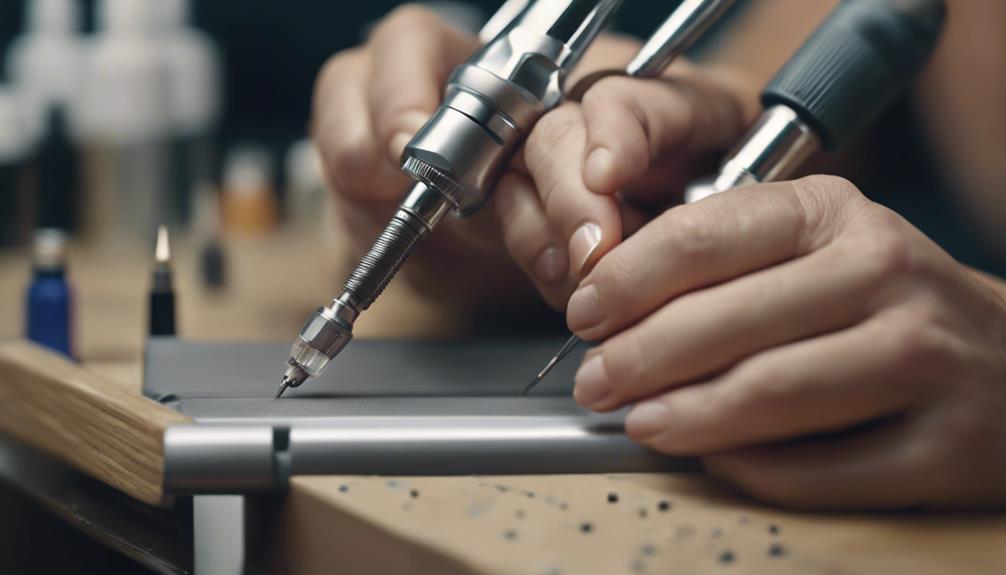
When removing acrylic nails in a salon setting, nail technicians often utilize a nail drill for efficient and precise results. The nail drill is a versatile tool that allows technicians to gently file away the acrylic material without causing damage to the natural nail underneath. Equipped with various drill bits, nail drills offer flexibility in adjusting speed and abrasiveness to suit different nail types and thicknesses. By using a nail drill, technicians can ensure a more controlled and uniform removal process, reducing the risk of accidental damage or discomfort to the client.
Moreover, nail drills save time and effort compared to manual filing, making them a preferred choice in busy salon environments. The precision offered by nail drills enables technicians to target specific areas with accuracy, resulting in a smoother and more consistent finish. Overall, the use of nail drills in acrylic nail removal exemplifies the industry's commitment to innovation and efficiency in delivering high-quality nail care services.
Moisturizing the Nails
Maintaining proper nail hydration is essential in preserving the health and appearance of nails, making moisturizing an integral step in nail care routines. Adequately moisturized nails are more flexible and less prone to breakage, promoting overall nail strength. Innovative nail moisturizers often contain ingredients like hyaluronic acid, collagen, and vitamins that deeply penetrate the nail bed, enhancing hydration and promoting nail health. These advanced formulations help restore moisture balance, improve flexibility, and impart a healthy sheen to the nails.
Regular moisturizing also plays a vital role in preventing common nail issues such as brittleness, dryness, and peeling. By incorporating cutting-edge moisturizing products into your nail care regimen, you can maintain the optimal moisture levels needed for healthy, resilient nails. Additionally, well-moisturized nails provide a smooth canvas for nail polish application, ensuring a flawless and long-lasting manicure. Prioritizing nail hydration through innovative moisturizing techniques is key to achieving strong, beautiful nails that make a lasting impression.
Applying Cuticle Oil
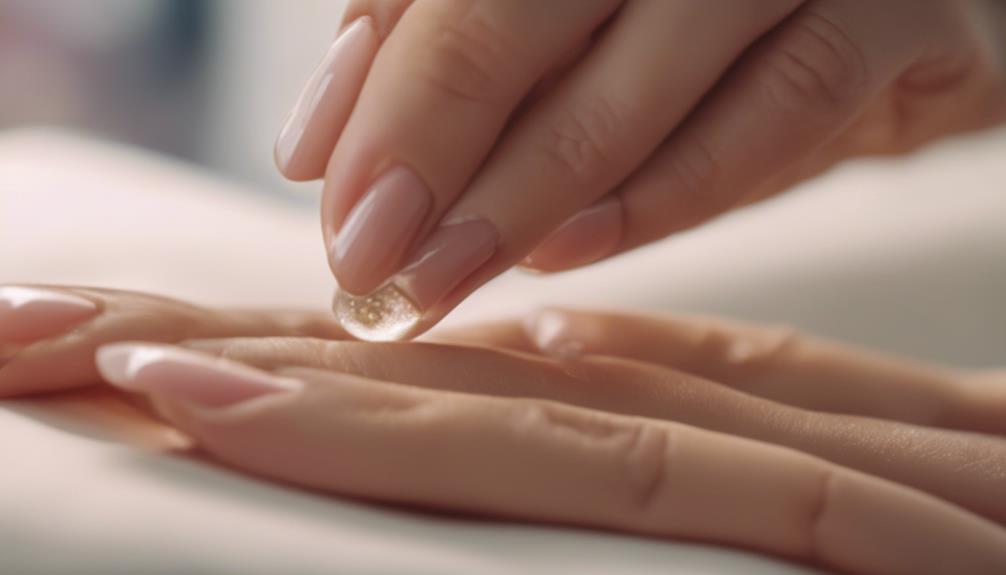
Proper nail hydration sets the foundation for healthy nails, and one effective way to enhance moisture retention and maintain nail health is through the regular application of cuticle oil. Cuticle oil contains essential vitamins and nutrients that help nourish the nails, cuticles, and surrounding skin. By applying cuticle oil daily, you can improve the flexibility and strength of your nails, preventing breakage and promoting overall nail health.
Innovations in cuticle oil formulations have led to the development of products that not only moisturize but also provide additional benefits such as strengthening, repairing, and protecting the nails. Some cuticle oils now incorporate ingredients like vitamin E, jojoba oil, almond oil, and botanical extracts to deliver optimal hydration and care. These advanced formulations are designed to penetrate deep into the nail bed, promoting healthy nail growth and improving the overall appearance of the nails.
Regularly applying cuticle oil as part of your nail care routine can help prevent dryness, brittleness, and damage, ensuring that your nails remain strong, hydrated, and beautiful.
Filing the Nail Surface
To enhance the smoothness and shape of acrylic nails, nail salons typically employ filing techniques as a crucial step in the removal process. Filing the nail surface helps in breaking the seal of the acrylic, making it easier to remove the artificial nails. Nail technicians use specific types of files designed for acrylic nails to ensure precision and care during this process.
Below is a table showcasing some common types of files used in nail salons for filing acrylic nails:
| File Type | Description |
|---|---|
| Straight File | Straight files are versatile and suitable for |
| shaping the nail and refining the edges. | |
| Buffer | Buffers are used to smooth out the nail surface |
| after filing, giving a polished look. | |
| Curved File | Curved files are ideal for shaping the acrylic |
| nails around the cuticles and edges. | |
| Grit File | Grit files come in varying coarseness levels |
| to efficiently remove acrylic without damaging | |
| the natural nail. | |
| Diamond File | Diamond files are durable and effective for |
| filing tough acrylic nails with precision. |
Final Clean-Up and Polish
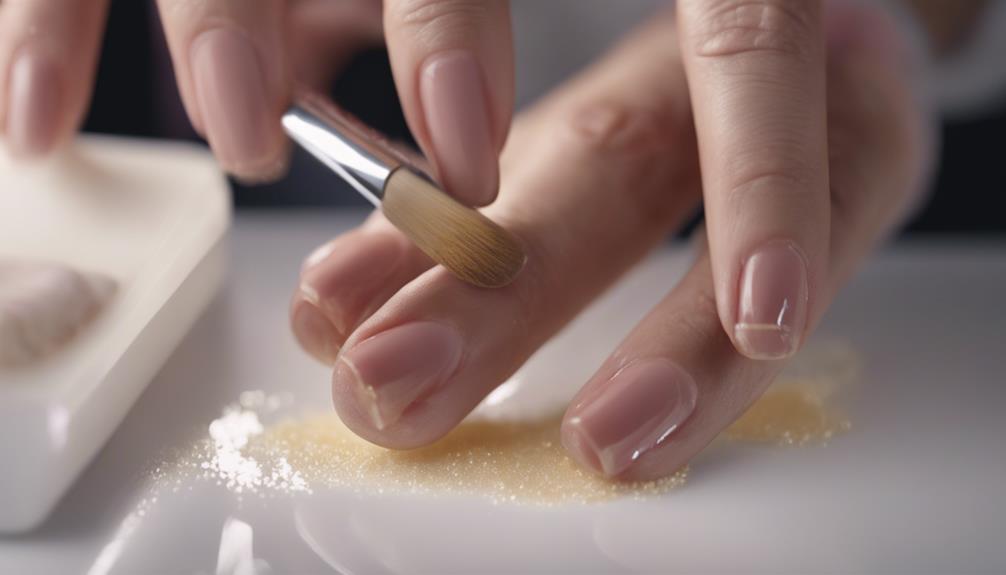
As the acrylic nails removal process comes to an end, nail technicians focus on final clean-up and polish to enhance the overall look and feel of the nails. This step involves buffing the nails to ensure smoothness, applying a top coat for protection and shine, and shaping the nails according to the client's preference. By paying attention to these details, the nails are given a polished and professional finish that leaves clients satisfied with the service provided.
Buffing for Smoothness
For achieving a flawless finish, the final step in the acrylic nail removal process involves buffing to smooth out any rough edges and preparing the nails for a fresh polish. Buffing is a crucial technique that nail technicians use to refine the nail surface, ensuring it is free from any imperfections left after the acrylic removal. By gently buffing the nails, technicians can create a smooth canvas for the upcoming polish application. This step not only enhances the appearance of the nails but also contributes to the longevity of the new polish, as a properly buffed surface allows for better adhesion. Additionally, buffing promotes nail health by improving circulation and stimulating nail growth, resulting in beautiful and healthy nails.
Applying Top Coat
After buffing the nails to perfection, the next crucial step in the acrylic nail removal process is the application of the top coat, which involves final clean-up and polish application. This step ensures a flawless finish and adds shine to the nails, giving them a professional look. Here are some key aspects of the top coat application process:
- Cleaning Residue: Thoroughly clean the nails to remove any remaining acrylic debris.
- Moisturizing: Apply cuticle oil to nourish and hydrate the skin around the nails.
- Base Coat Application: Start with a base coat to protect the natural nail and ensure the polish adheres well.
- Polishing: Apply the desired nail polish color and finish with a top coat for added durability and shine.
Nail Shaping and Filing
Efficiently shaping and filing the nails is a crucial step in the final clean-up and polish process after acrylic nail removal. Nail technicians utilize innovative techniques and tools to ensure precision and perfection in this stage. Electric files are commonly used to quickly and accurately shape the nails, allowing for a seamless transition from the old acrylics to the natural nail. Emery boards and buffers help refine the shape and smooth out any rough edges, creating a flawless canvas for the final polish. Attention to detail is key during this step, as it sets the foundation for a stunning nail finish. By employing advanced shaping and filing methods, nail salons can deliver impeccable results that leave clients feeling pampered and polished.
Frequently Asked Questions
Are There Any Alternative Methods to Remove Acrylic Nails?
There are alternative methods to remove acrylic nails that aim to minimize damage and enhance efficiency. Innovations like acetone-free nail polish removers, steam removal systems, and electric nail drills offer options for a more comfortable and modern nail removal experience.
How Long Does It Take for Acrylic Nails to Dissolve in Acetone?
The time it takes for acrylic nails to dissolve in acetone varies depending on factors like thickness and quality. Generally, this process can take around 30 minutes to an hour. Professional removal ensures safety and precision.
Can Acrylic Nails Be Safely Removed at Home?
Seeking safe ways to remove acrylic nails at home is a common query for nail enthusiasts. While it's possible, professional removal at a salon is recommended for optimal results and minimal damage to natural nails.
What Are the Potential Risks of Using a Nail Drill?
When considering the potential risks of using a nail drill, it is crucial to prioritize safety measures. Common risks include nail damage, infections, and over-filing. Proper training, quality equipment, and regular maintenance are essential for minimizing these risks.
How Often Should Cuticle Oil Be Applied to Nails?
Cuticle oil should be applied to nails at least twice daily to maintain healthy and hydrated cuticles. Regular application improves nail flexibility and strength. Consistent use promotes nail growth and prevents hangnails and dryness.

